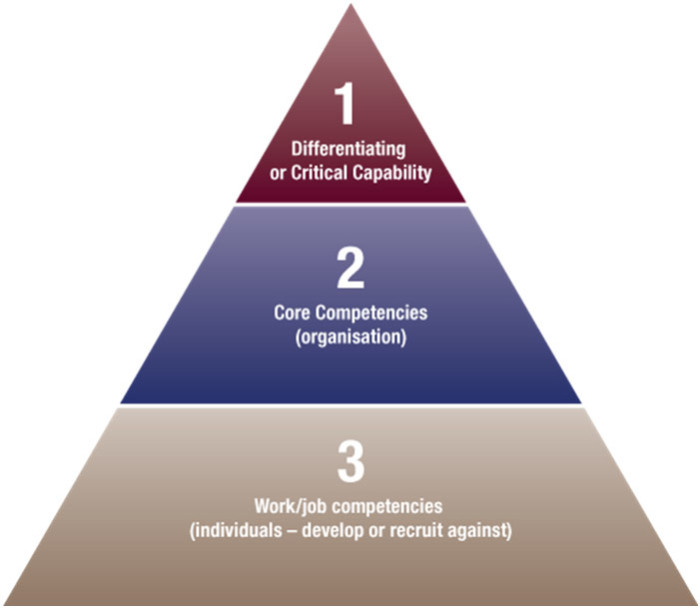How to design your organisation around core competencies

Every organisation operates in a unique competitive situation. To implement its strategy, each firm must develop and build capabilities and competencies that are critical to its strategic intent.
In the past there has been sole focus on developing individual work competencies (i.e., a bottom up approach) with little attention paid to developing a firm’s critical capabilities and core competencies. However this emphasis is now changing for the reasons outlined below.
A three level model of capabilities/competencies

The above pyramid model, that includes three types or levels of capabilities and competencies, offers a top down approach to capability and competency development:
- Differentiating or critical capabilities (of firms);
- Core competencies (of firms);
- Work competencies (of individuals and teams).
Differentiating or critical capabilities (of firms)
Differentiating or critical capabilities either:
- Differentiate a firm from its competitors (i.e., its point of difference);
- Characterise a firm to its customers;
- Contribute significantly to success.
Differentiating or critical capabilities (or a single capability, which may be the case for many firms), are therefore vital to the success of a firm, because: they constitute a key source of sustainable competitive advantage; and they are one of the main reasons why customers purchase products or services from one firm versus another.
These capabilities represent what the firm is known for, what it is good at doing, and how it patterns its activities to deliver value. They define many of the intangibles that investors pay attention to, including the company brand to which customers relate to, and the culture that shapes employees’ behaviour. They become the identity of the firm and the key to implementing the business strategy.
Some of the traditional and accepted capabilities include:
- Efficiency (e.g., lean manufacturing);
- Customer service;
- Quality;
- Speed of change or agility;
- Size or geographic spread.
Differentiating or critical capabilities are one of the main reasons why customers purchase products or services from one firm versus another.
Some emerging capabilities for many firms to succeed in the future include:
- Risk management (with volatile and changing markets, anticipating and managing risk will be critical to sustainability);
- Social responsibility (with increasing concern for environmental issues increasing the ability to attract customers and employees);
- Simplicity (leading to greater responsiveness);
- Connection (with technology enabling the workplace of the future);
- Innovation (e.g., business models, business processes, customer interfaces or channels, administration processes as well as products).
Whatever the case, it is important to focus on developing and strengthening the firm’s critical capabilities, given that this is the source of competitive advantage and sustainability.
Core competencies (of firms)
Core competencies directly relate to the key activities or functions that a firm undertakes in conducting its business. For example, the mythical XWZ Widget Company’s core competencies would include: designing widgets; manufacturing and distributing widgets; and marketing and selling widgets.
For the purposes of this example, let’s assume that the critical capability of the XYZ Widget Company is the quality of widget that it manufactures – this represents its source of competitive advantage.
Depending upon the business strategy, some core competencies will be more important than others at any particular time in the business environment or cycle. For example, it may be the case that a key business strategy of the XYZ Widget Company is to design a new type of widget.
Therefore roles associated with the design of the new type of widget become more important because they are directly linked the business strategy at that particular point in time. Once this new widget is designed, then there may be a shift to the manufacturing core competency as becoming more important.
Strengthening a firm’s critical capabilities and core competencies
Based on the above considerations, how can a firm best strengthen its critical capabilities and more important core competencies? Or put another way, what are the key drivers of these critical capabilities, and more importantly core competencies that are adding value to a firm?
Job roles incorporating either innovation or quality should be adequately resourced and invested in, including a focus on improving the performance of people in those roles.
We can think about these key drivers consisting of any of the following:
- Sales and revenue — maintaining or increasing sales to existing customers, securing new customer sales, optimising prices;
- Stakeholder relations – contributing to customer service/satisfaction, maintaining the firm’s reputation or brand with stakeholders;
- Costs — achieving efficiencies in production and delivery of products and services;
- Quality — maintaining or enhancing the quality of products and services;
- Innovation — incorporating research and development, strategy, design, capital expenditure, securing resources, feasibility studies, marketing research, etc., all relating to the development of existing or new products and services;
- Organisational capability — contributing to organisational efficiency, recruitment, development, and the engagement and retention of people;
- Reputation/risk management — risk management and compliance, protecting the firm’s reputation;
- Financial performance — determining cash flow, borrowings, ROI, tax management;
- Processes/systems (including ICT) – designing, implementing and maintaining processes and systems improvements.
Some of these drivers will be more significant than others. In the case of the previous mythical XYZ Widget Company, innovation (which relates to widget design – a more important core competency) becomes a more significant key driver. Quality is also an important key driver as it directly relates to the critical capability of the firm.
Organisational structures should reflect the importance of innovation and quality. Job roles incorporating either innovation or quality should be adequately resourced and invested in, including a focus on improving the performance of people in those roles (i.e., the bottom level of the pyramid). There is a direct line of sight between those job roles and the achievement of the business strategy and the sustainability of the firm.
Conclusion
The three layered pyramid model thus offers a top down, integrated approach to intelligent investment in people and resources where it matters most.






